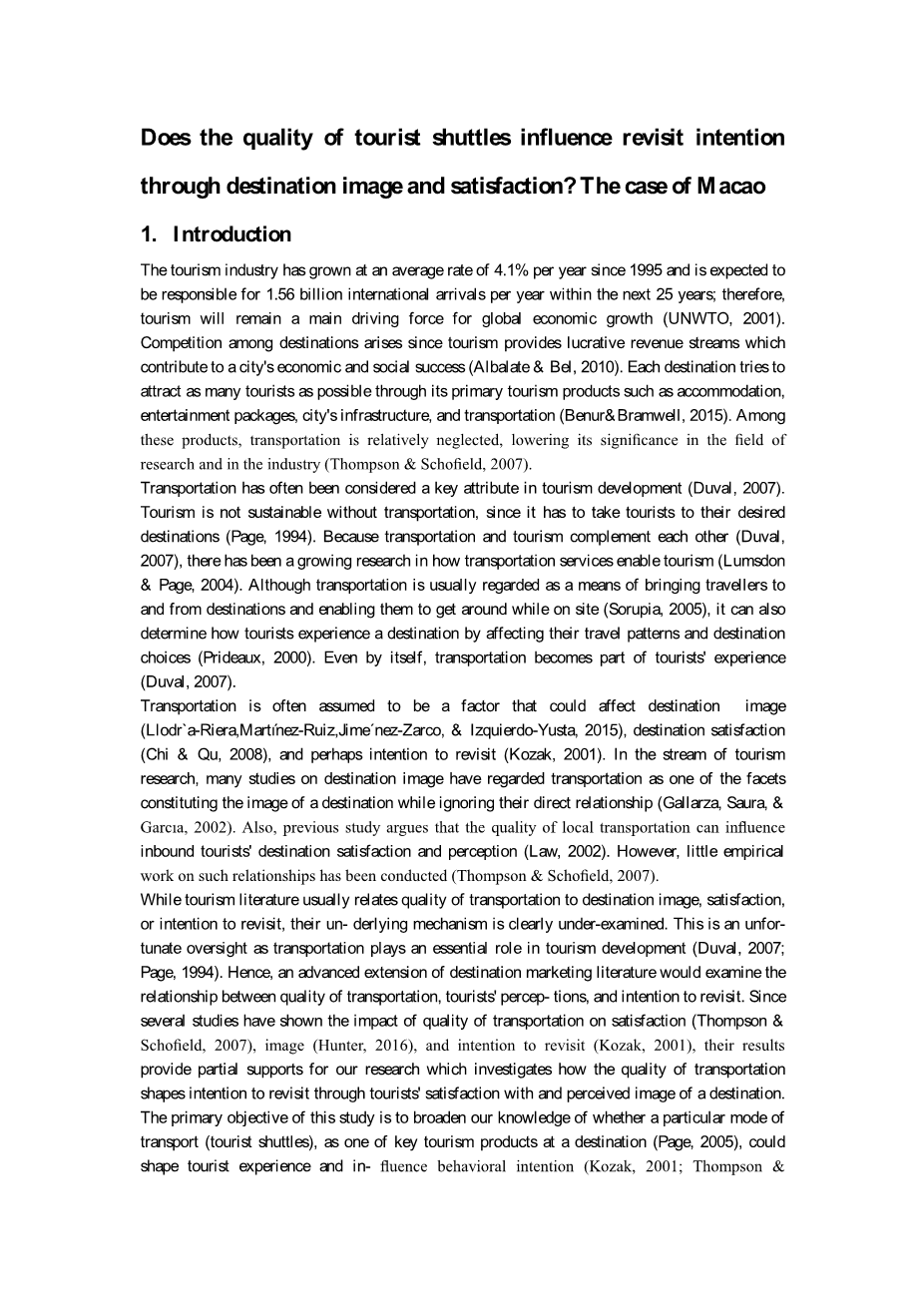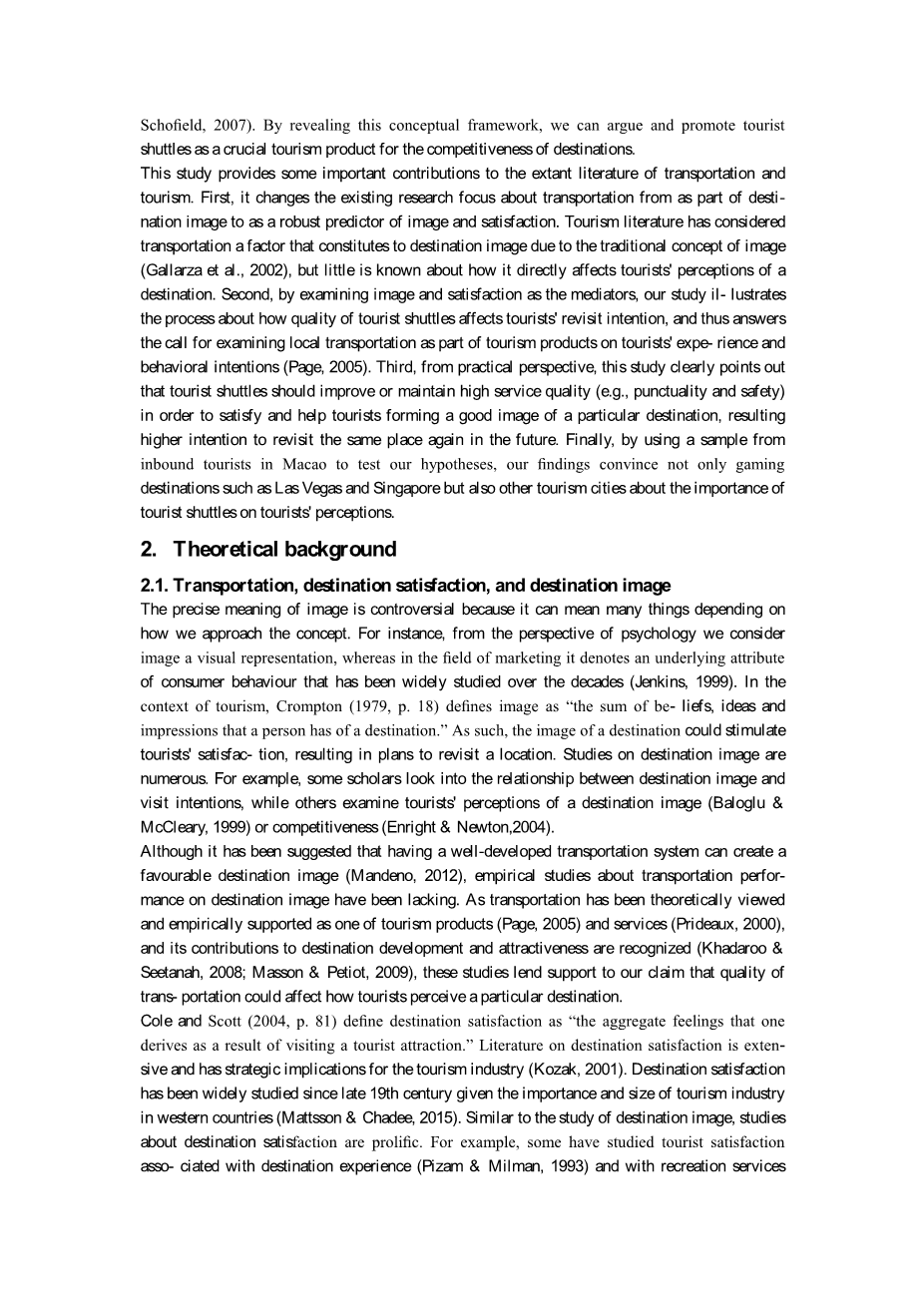

英语原文共 6 页,剩余内容已隐藏,支付完成后下载完整资料
Does the quality of tourist shuttles influence revisit intention through destination image and satisfaction? The case of Macao
1. Introduction
The tourism industry has grown at an average rate of 4.1% per year since 1995 and is expected to be responsible for 1.56 billion international arrivals per year within the next 25 years; therefore, tourism will remain a main driving force for global economic growth (UNWTO, 2001). Competition among destinations arises since tourism provides lucrative revenue streams which contribute to a city#39;s economic and social success (Albalate amp; Bel, 2010). Each destination tries to attract as many tourists as possible through its primary tourism products such as accommodation, entertainment packages, city#39;s infrastructure, and transportation (Benuramp;Bramwell, 2015). Among these products, transportation is relatively neglected, lowering its significance in the field of research and in the industry (Thompson amp; Schofield, 2007).
Transportation has often been considered a key attribute in tourism development (Duval, 2007). Tourism is not sustainable without transportation, since it has to take tourists to their desired destinations (Page, 1994). Because transportation and tourism complement each other (Duval, 2007), there has been a growing research in how transportation services enable tourism (Lumsdon amp; Page, 2004). Although transportation is usually regarded as a means of bringing travellers to and from destinations and enabling them to get around while on site (Sorupia, 2005), it can also determine how tourists experience a destination by affecting their travel patterns and destination choices (Prideaux, 2000). Even by itself, transportation becomes part of tourists#39; experience (Duval, 2007).
Transportation is often assumed to be a factor that could affect destination image (Llodr`a-Riera,Martiacute;nez-Ruiz,Jimeacute;nez-Zarco, amp; Izquierdo-Yusta, 2015), destination satisfaction (Chi amp; Qu, 2008), and perhaps intention to revisit (Kozak, 2001). In the stream of tourism research, many studies on destination image have regarded transportation as one of the facets constituting the image of a destination while ignoring their direct relationship (Gallarza, Saura, amp; Garcıa, 2002). Also, previous study argues that the quality of local transportation can influence inbound tourists#39; destination satisfaction and perception (Law, 2002). However, little empirical work on such relationships has been conducted (Thompson amp; Schofield, 2007).
While tourism literature usually relates quality of transportation to destination image, satisfaction, or intention to revisit, their un- derlying mechanism is clearly under-examined. This is an unfor- tunate oversight as transportation plays an essential role in tourism development (Duval, 2007; Page, 1994). Hence, an advanced extension of destination marketing literature would examine the relationship between quality of transportation, tourists#39; percep- tions, and intention to revisit. Since several studies have shown the impact of quality of transportation on satisfaction (Thompson amp; Schofield, 2007), image (Hunter, 2016), and intention to revisit (Kozak, 2001), their results provide partial supports for our research which investigates how the quality of transportation shapes intention to revisit through tourists#39; satisfaction with and perceived image of a destination. The primary objective of this study is to broaden our knowledge of whether a particular mode of transport (tourist shuttles), as one of key tourism products at a destination (Page, 2005), could shape tourist experience and in- fluence behavioral intention (Kozak, 2001; Thompson amp; Schofield, 2007). By revealing this conceptual framework, we can argue and promote tourist shuttles as a crucial tourism product for the competitiveness of destinations.
This study provides some important contributions to the extant literature of transportation and tourism. First, it changes the existing research focus about transportation from as part of desti- nation image to as a robust predictor of image and satisfaction. Tourism literature has considered transportation a factor that constitutes to destination image due to the traditional concept of image (Gallarza et al., 2002), but little is known about how it directly affects tourists#39; perceptions of a destination. Second, by examining image and satisfaction as the mediators, our study il- lustrates the process about how quality of tourist shuttles affects tourists#39; revisit intention, and thus answers the call for examining local transportation as part of tourism products on tourists#39; expe- rience and behavioral intentions (Page, 2005). Third, from practical perspective, this study clearly points out that tourist shuttles should improve or maintain high service quality (e.g., punctuality and safety) in order to satisfy and help tourists forming a good image of a particular destination, resulting higher intention to revisit the same place again in the future. Finally, by using a sample from inbound tourists in Macao to test our hypotheses, our findings convince not only gaming destinations such as Las Vegas and Singapore but also other tourism cities about the importance of tourist shuttles on tourists#39; perceptions.
2. Theoretical background
2.1. Transportation, destination satisfaction, and destination image
The precise meaning of image is controversial because it can mean many things depending on how we approach the concept. For instance, from the perspective of psychology we consider image a visual representation, whereas in the field of marketing it denotes an underlying attribute of consumer behaviour that has been widely studied over the decades (Jenkins, 1999). In the context of tourism, Crompton (1979, p. 18) defines image as “the sum of be- liefs, ideas and impressions that a person has of
剩余内容已隐藏,支付完成后下载完整资料
资料编号:[468838],资料为PDF文档或Word文档,PDF文档可免费转换为Word
以上是毕业论文外文翻译,课题毕业论文、任务书、文献综述、开题报告、程序设计、图纸设计等资料可联系客服协助查找。
您可能感兴趣的文章
- COVID-19时期的旅游业和可持续发展:以西班牙为例外文翻译资料
- 农民相对剥夺感对乡村旅游可持续发展的影响机制外文翻译资料
- 校园大学生的旅行行为——以亚洲某乡村大学为例外文翻译资料
- 内容旅游与地方社区响应:鹫宫的“幸运之星”和“协作动漫旅游”外文翻译资料
- 基于符号互动理论的遗产旅游资源开发与重塑——以良渚古城遗址为例外文翻译资料
- 在TikTok上映射互联网名人:探索注意力、经济和可见性劳动力外文翻译资料
- 基于社区游客视角的环境责任行为的概念和度量外文翻译资料
- 温泉小镇的再造:维希的独特案例——副标题外文翻译资料
- 基于IP理念的桐乡丰子恺文化旅游开发研究外文翻译资料
- 特殊事件对旅游业的影响及其应对措施研究——新冠肺炎疫情对全球旅游业的影响及其应对措施外文翻译资料


